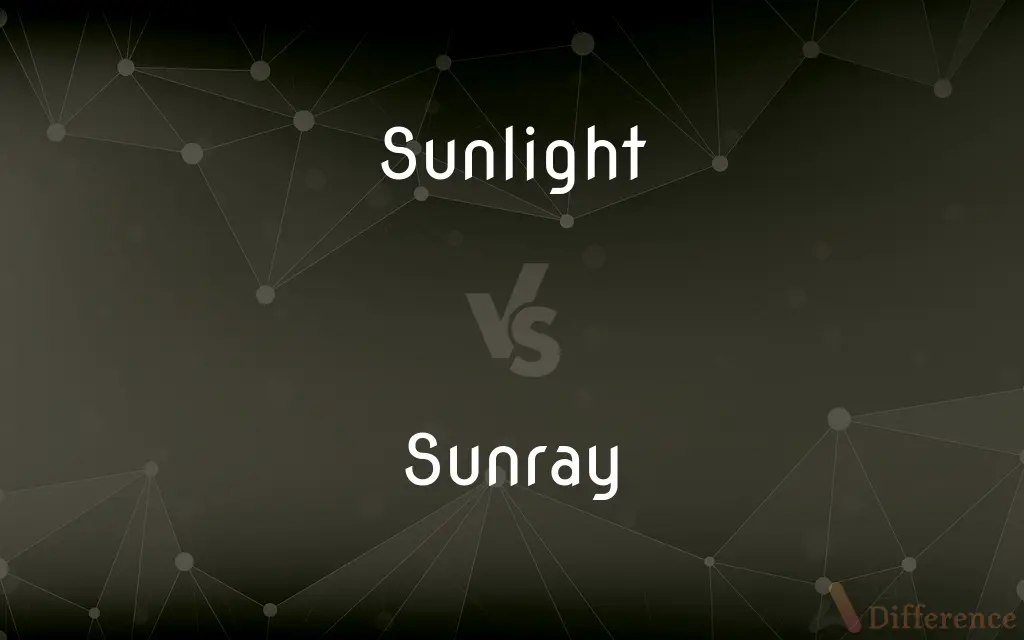Sunlight vs. Sunray — What's the Difference?
Edited by Tayyaba Rehman — By Fiza Rafique — Updated on April 20, 2024
Sunlight is the general illumination from the Sun, while sunrays are focused beams of light visible due to scattering particles.

Difference Between Sunlight and Sunray
Table of Contents
ADVERTISEMENT
Key Differences
Sunlight encompasses all the light and energy emitted by the Sun, which reaches the Earth and is vital for photosynthesis and maintaining the Earth's temperature. Whereas, sunrays specifically refer to the paths of light that are visible when sunlight is scattered by particles in the atmosphere, such as during a cloudy day or in misty conditions.
Sunlight is often considered as a continuous spread of light covering a wide area, providing daylight and influencing the global climate. On the other hand, sunrays can be seen as distinct beams or lines of light, often dramatic in appearance, and typically visible when conditions allow for the light to be filtered through gaps in clouds or other obstructions.
The intensity of sunlight can vary based on the Earth's rotation and orbit, affecting seasonal temperatures and weather patterns globally. Conversely, sunrays, while they are a component of sunlight, do not significantly impact climate but can vary visually from moment to moment and place to place.
In photography and artistic representation, sunlight is used to depict a variety of times and moods, offering a broad light source. Sunrays, however, are often used to add a poignant or heavenly effect, highlighting specific areas or subjects within the composition.
Health-wise, exposure to sunlight enables the production of vitamin D in the skin, essential for bone health and immune function. Sunrays, in this context, are just one aspect of sunlight's composition and contribute similarly, yet their visibility does not alter their health impact.
ADVERTISEMENT
Comparison Chart
Definition
General illumination from the Sun.
Visible beams of light from the Sun.
Visibility
Diffuse, covers broad areas.
Focused, seen as distinct beams.
Impact on Earth
Affects climate, weather, photosynthesis.
Primarily visual, no direct climate impact.
Typical Usage
Describes day-to-day light conditions.
Used in specific atmospheric conditions.
Artistic Representation
Broad use in various lighting scenarios.
Used for dramatic effects and focus.
Compare with Definitions
Sunlight
A source of energy and heat.
Solar panels capture sunlight to generate electricity.
Sunray
Focused light visible due to particulate matter.
Dust motes danced in the sunray coming through the window.
Sunlight
Symbolic of cheerfulness or brightness.
Her smile was as warm as sunlight.
Sunray
A beam of sunlight that has broken through an opening.
A sunray peeked through the dark clouds.
Sunlight
The natural light from the Sun.
The room filled with sunlight every morning.
Sunray
Used to emphasize dramatic visuals in nature.
The sunrays through the forest created a magical scene.
Sunlight
The total spectrum of the electromagnetic radiation given off by the Sun.
Plants utilize sunlight to perform photosynthesis.
Sunray
Seen during specific atmospheric conditions like mist or fog.
Early morning sunrays illuminated the misty road.
Sunlight
Daylight, the light during daytime.
Sunlight is essential for a healthy lifestyle.
Sunray
A beam of sunlight; a sunbeam
Sunlight
Light from the sun
A shaft of sunlight
Sunray
Sunray is a term used in radio voice procedure (the conventions used in radio conversation) in the British military and in the military of nations strongly influenced by the British. It refers to the formation or unit commander and serves as a synonym of "leader".
Sunlight
The light of the sun; sunshine.
Sunray
A beam of artificial light, especially one rich in ultraviolet
Sunlight
Sunlight is a portion of the electromagnetic radiation given off by the Sun, in particular infrared, visible, and ultraviolet light. On Earth, sunlight is scattered and filtered through Earth's atmosphere, and is obvious as daylight when the Sun is above the horizon.
Sunray
A plant, Enceliopsis nudicaulis, that has a broad, yellow flowerhead
Sunlight
All the electromagnetic radiation given off by the Sun, especially that in the visible spectrum that bathes the Earth.
Sunlight on the skin gives you vitamin D.
Sunray
A ray of sunlight
Sunlight
(figuratively) Brightness, hope; a positive outlook.
Sunray
Herb having a basal cluster of gray-green leaves and leafless stalks each with a solitary broad yellow flower head; desert areas Idaho to Arizona
Sunlight
Synonym of sunrise.
Sunray
A ray of artifical ultraviolet light from a sunray lamp
Sunlight
To work on the side (at a secondary job) during the daytime.
Sunray
Pleated or tucked in lines radiating from a circular edge;
Blouse with a sunburst yoke
Sunray fan pleats below the hips
Sunlight
The light of the sun.
Sunlight
The rays of the sun;
The shingles were weathered by the sun and wind
Common Curiosities
How does sunlight affect the Earth?
Sunlight affects the Earth by providing light, heat, and energy, which influence climate, weather, and the biological processes of organisms.
Are sunrays hot?
Sunrays are as hot as the sunlight they derive from; however, their heat is not concentrated enough to feel different from ambient sunlight.
Can sunrays be harmful?
Like any sunlight, excessive exposure to sunrays without protection can lead to skin damage and other health issues.
Why do sunrays seem to come from a point in the sky?
This visual effect, known as crepuscular rays, occurs when sunlight streams through gaps in clouds or other obstructions, creating the appearance of rays emanating from a single point.
Does the appearance of sunrays depend on the time of day?
Yes, sunrays are most commonly observed during times when the sun is lower in the sky, such as during sunrise or sunset.
What role do sunrays play in photography?
In photography, sunrays can be used to enhance the aesthetic appeal of an image, providing a dramatic effect and emphasizing light and shadow.
What is sunlight?
Sunlight is the general illumination provided by the Sun, including all types of light and energy it emits.
What is a sunray?
A sunray is a visible beam of sunlight that appears when sunlight is scattered by particles in the atmosphere.
Are sunrays different in different climates?
Yes, the visibility and appearance of sunrays can vary significantly depending on atmospheric conditions, which are influenced by local climates.
Can sunrays be artificially replicated?
Artificial lighting techniques can mimic the appearance of sunrays in photography and theater.
Is sunlight more important than sunrays?
Sunlight is essential for life on Earth in many ways, making it generally more significant than sunrays, which are primarily a visual phenomenon.
Can the direction of sunrays change rapidly?
The apparent direction of sunrays can change with the movement of clouds and the sun, altering how we perceive them from the ground.
How can one safely observe sunrays?
Observing sunrays does not require any special precautions; however, looking directly at the sun during this time should be avoided to prevent eye damage.
Do sunrays affect plants differently than diffuse sunlight?
Plants use light for photosynthesis, and while sunrays are a form of sunlight, they do not affect plants differently than diffuse sunlight.
What causes the color variations in sunrays?
The scattering of sunlight by atmospheric particles causes the colors seen in sunrays, particularly during sunrise and sunset.
Share Your Discovery

Previous Comparison
Forecast vs. Warning
Next Comparison
Gharial vs. CrocodileAuthor Spotlight
Written by
Fiza RafiqueFiza Rafique is a skilled content writer at AskDifference.com, where she meticulously refines and enhances written pieces. Drawing from her vast editorial expertise, Fiza ensures clarity, accuracy, and precision in every article. Passionate about language, she continually seeks to elevate the quality of content for readers worldwide.
Edited by
Tayyaba RehmanTayyaba Rehman is a distinguished writer, currently serving as a primary contributor to askdifference.com. As a researcher in semantics and etymology, Tayyaba's passion for the complexity of languages and their distinctions has found a perfect home on the platform. Tayyaba delves into the intricacies of language, distinguishing between commonly confused words and phrases, thereby providing clarity for readers worldwide.














































